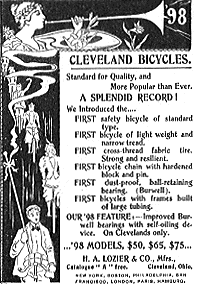
 |
|
 1898 ad for Cleveland bicycles from Harper’s Magazine more old ads |
It’s normal to hop on a bike and push down on the pedals. But, if that’s all you do, you’ll never develop a smooth, efficient pedal stroke. Practice this instead: When the pedals reach 3 o’clock on the pedal stroke, pull back with a swiping motion as if you are wiping mud off the bottom of your shoes. You’ll notice an immediate boost in power, especially on hills. And, if you focus on this technique for only a few rides, your pedal stroke will smooth out and become far more efficient. In time, you’ll do it automatically. BACK Two nerves run through your palms and they can become painfully numb from cycling. In fact, my high-school chum Bruce Holden once lost the feeling in both hands for six weeks after a ride we took into the White Mountain of New Hampshire. What’d he do wrong? He made three serious mistakes: 1 He rode without gloves (always ride with comfortable, nicely padded cycling gloves because they save your hands and also provide palm protection if you crash); 2 He gripped the bars too tightly (relax your grip); and 3 He didn’t move his hands around to different parts of the handlebars (every 10 minutes move your hands and grip in a different place). Avoid these mistakes and you should avoid palm problems. BACK One of the most common mistakes is riding while you’re too tight in the upper body. If you see someone riding and you see locked shoulders and straight, stiff arms, you’re looking at someone who’s probably going to have a sore neck and arms at the end of the ride and someone who’s tiring out muscles for no good reason. Relax when you’re riding. Keep nice, loose, bent arms. Drop your shoulders and get comfortable. Train yourself to relax by, every 15 minutes or so, shrugging your shoulders to get them to drop and relax. Bring your elbows down and closer together and shake your arms to relax them. Bend your elbows. Exhale. Think about letting all that tension leave your neck, shoulders and arms. You’ll feel a whole lot better and have a lot more control of your bike if you can learn to ride comfortably like this. BACK An important safety measure is always keeping at least one of your thumbs beneath the handlebars. If you can do this, you’ll avoid crashing due to your hands slipping off the bars. This can happen if you hold onto the tops with all your fingers over the handlebars. In this position, if you hit a bump and aren’t prepared, your hands can slip off causing a crash. This common accident can be prevented by simply keeping your thumbs in the right place. BACK If you suffer from a sore neck on rides and you’re satisfied with the fit of your bike, you should try adding sets of push-ups to your workout routine. Even if you only do them a few days a week, I think you’ll find that they make your neck pain go away. This happens because the push-ups strengthen the muscles that support the neck, which means they won’t tire on rides and get sore. BACK If you think of yourself as the bike’s engine and try to shift frequently to maintain a comfortable and steady pedaling effort, you’ll begin to use the gears more effectively. Keep in mind that shifting works best when you apply only light pedal pressure to the pedals. So shift before the hill gets too steep and never stomp the pedals until a shift has taken place. Most people find a pedal cadence (how many times one pedal goes around in a minute) of about 60 to 90 rpm about right. Find what feels good for you and then shift every time it’s either too hard or too easy to pedal. When you realize that you need to shift, use the right shift lever for small adjustments in pedal effort and use the left lever for major changes in how hard or easy it is to pedal. Most important: don’t be afraid to shift. Shift often and you’ll get good at it and on rides you’ll save energy and feel better. BACK When you come into a scary turn, if you can get yourself to look to the inside of the turn (don’t just turn your eyes, turn your head and shoulders) you’ll find that the corner is not so scary anymore and you’ll scoot right around it. BACK Mountain bike champ Juli Furtado once said, “The faster you go, the easier it gets.” It’s great advice. Most of the bike handling problems people have are related to riding the brakes too much. If you can back off the brakes and let the bike roll, you’ll discover the wonders of momentum: with a little more speed, the bike gains stability, it gets easier to hold the good line and you steamroll obstacles that used to give you fits. BACK To make off-road rides smoother and more comfortable, try riding in slightly larger gears. This allows you to support more of your weight on the pedals and get some off your seat, which allows “floating” over, rather than pounding into ruts, roots and other rough stuff. The same trick works riding your road bike over bumpy pavement. Give it a try! BACK New cyclists are often afraid to ride on busy streets because they’re not confident getting into the pedals, shifting and braking. You could pedal laps around the neighborhood. A more exciting approach is putting your bike in the car (bring along a cooler with some goodies) and driving to a safe country road. Here you can ride in either/both direction(s) from your car to see some scenery while practicing your skills on a safe road! BACK |
|